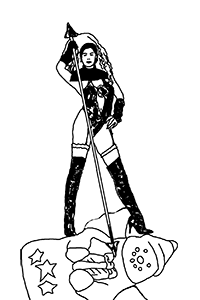“In her last appearance, in Introitus (2010), she interprets the hymn21 of the city, with the help of a phallic ocarina of imitation pre-Colombian style, which is used today as a tourist souvenir. Conscious of the tonal limitations of this instrument, Corazón Desfasado embarks on the reconstruction of the hymn from memory. The action of trying to reproduce it reinforces the search for cultural identity that at the same time, puts in evidence a search for sexual identity. The subversion of symbols is converted here into a decolonialising action, since it is confronted by history codified by the West, in its formation of subjectivities, as is reflected by the imperialist project of modernity. The strategies of decolonial aesthetics aim to get around the imperial canons and instituted values. Art with decolonial concerns moves its centre from the mythic and theological act of ‘creation’, the paradigmatic figure of modernity, toward its own territory, expanded from its own archetypes. Decolonial art becomes a form of filtering and critically re-elaborating the varied and contradictory information of the world today, using a tool of thought and critical action that starts to affect general culture, producing reactions and awakening consciences. In summary, it is an aesthetic located on the theoretical horizon that permits the inquiry of art in a particular context, different to the models developed by the West.”
Dolores Galindo.
LATIN AMERICA’S EPISTEMIC BREAK: TOWARDS A DECOLONIAL AESTHETICS
(2011) P.52
Extract.
“In her last appearance, in Introitus (2010), she interprets the hymn21 of the city, with the help of a phallic ocarina of imitation pre-Colombian style, which is used today as a tourist souvenir. Conscious of the tonal limitations of this instrument, Corazón Desfasado embarks on the reconstruction of the hymn from memory. The action of trying to reproduce it reinforces the search for cultural identity that at the same time, puts in evidence a search for sexual identity. The subversion of symbols is converted here into a decolonialising action, since it is confronted by history codified by the West, in its formation of subjectivities, as is reflected by the imperialist project of modernity. The strategies of decolonial aesthetics aim to get around the imperial canons and instituted values. Art with decolonial concerns moves its centre from the mythic and theological act of ‘creation’, the paradigmatic figure of modernity, toward its own territory, expanded from its own archetypes. Decolonial art becomes a form of filtering and critically re-elaborating the varied and contradictory information of the world today, using a tool of thought and critical action that starts to affect general culture, producing reactions and awakening consciences. In summary, it is an aesthetic located on the theoretical horizon that permits the inquiry of art in a particular context, different to the models developed by the West.”
Dolores Galindo.
LATIN AMERICA’S EPISTEMIC BREAK: TOWARDS A DECOLONIAL AESTHETICS
(2011) P.52
Extract.
“In her last appearance, in Introitus (2010), she interprets the hymn21 of the city, with the help of a phallic ocarina of imitation pre-Colombian style, which is used today as a tourist souvenir. Conscious of the tonal limitations of this instrument, Corazón Desfasado embarks on the reconstruction of the hymn from memory. The action of trying to reproduce it reinforces the search for cultural identity that at the same time, puts in evidence a search for sexual identity. The subversion of symbols is converted here into a decolonialising action, since it is confronted by history codified by the West, in its formation of subjectivities, as is reflected by the imperialist project of modernity. The strategies of decolonial aesthetics aim to get around the imperial canons and instituted values. Art with decolonial concerns moves its centre from the mythic and theological act of ‘creation’, the paradigmatic figure of modernity, toward its own territory, expanded from its own archetypes. Decolonial art becomes a form of filtering and critically re-elaborating the varied and contradictory information of the world today, using a tool of thought and critical action that starts to affect general culture, producing reactions and awakening consciences. In summary, it is an aesthetic located on the theoretical horizon that permits the inquiry of art in a particular context, different to the models developed by the West.”
Dolores Galindo.
LATIN AMERICA’S EPISTEMIC BREAK: TOWARDS A DECOLONIAL AESTHETICS
(2011) P.52
Extract.


 Wordpress snowstorm powered by nksnow
Wordpress snowstorm powered by nksnow